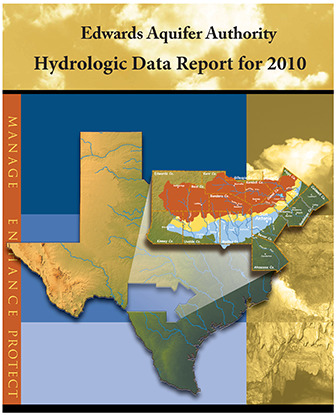Edwards Aquifer Authority Hydrologic Data Report for 2010

| Author | Hamilton M, Johnson S, Esquilin R, Burgoon C, Luevano G, Gregory D, Mireles J, Gloyd R and Schindel GM |
| Year | 2011 |
| Description | Annual report for 2010 on recharge, discharge, water levels and water quality in the Edwards Aquifer San Antonio Region |
| Report Number | 11-01 |
| Publisher | Edwards Aquifer Authority |
| Location | Edwards Aquifer - San Antonio Area |
| Cover | View Download |
| File | View Download |
| Summary |
|
(Excerpted from the report Summary) This report presents results of the Edwards Aquifer Authority (EAA) Hydrologic Data Collection Program for calendar year 2010. … Water levels at the Bexar County index well (J-17) fluctuated with rainfall events during 2010 but were above the historical average for most of the year. …Other wells in the region were generally above their respective mean levels, with the exception of the Uvalde County index well (J-27), which was below the mean.… Annual precipitation in the Edwards Aquifer region was above the mean in 2010, with the exception of the precipitation measured by the gauges located in Uvalde and Hondo. …Total estimated recharge to the Edwards Aquifer in 2010 was well above the median….In calendar year 2010, groundwater discharge from the Edwards Aquifer through wells and springs totaled 862,633 acre-feet. This amount is above the median total discharge of 705,600 acre-feet for the period of record (1934–2010)…. Water quality analytical results indicated the presence of bacteria counts as high as 530 CFU/100 mL for fecal streptococcus and 230 CFU/ 100 mL for fecal coliform in wells sampled under the routine sampling program. Bacteria detections in wells for 2010 were more frequent than for calendar year 2009, probably because of more abundant rainfall and runoff than occurred in the previous calendar year. Bacteria results from springs and streams were frequently positive but not elevated above the range typically seen. Regulated metals were not detected above a regulatory standard, although iron was detected above the secondary standard in wells and manganese was detected above the secondary standard in surface waters. Nitrate-nitrite as nitrogen was detected at elevated levels in wells and streams, with one well sample exceeding the regulatory limit for drinking water of 10 mg/L. … Low concentrations of organic compounds (below drinking water standards) were detected in wells, springs, and streams. Some of these detections were suspectedto be from post-sample-collection contamination. However, notable detections include tetrachloroethane and toluene in wells and benzene, 2,4-D, pyridine, and monocrotophos in spring samples. Detections of the organic compounds mentioned above are a concern and warrant continued monitoring. The EAA’s aquiferwide, water quality sampling program will continue to monitor wells, streams, and springs for indications of water quality degradation throughout the region. Focused investigations in areas with water quality degradation will be initiated as needed. … The EAA responded to three significant sanitary sewer overflows that occurred in August of 2010. The overflows resulted in the release of raw sewage to the surface at three locations in the north and northwest parts of Bexar County. …Only one of the wells sampled following these overflow appeared to be directly impacted. The potentially impacted well is located in the area of the August 20 event and is not an Edwards Aquifer well. |
Search for Documents
Advance Search
Explore EAA's Scientific Reports
- All Reports
- Weather Modification
- Geology
- Water Use and Conservation
- Geochemistry
- Water Resources Planning and Management
- Floods and Drought
- Water Quality
- Climatology
- Surface Water / Groundwater Relationship
- Biology
- Springs, Groundwater Discharge
- Archaeology
- RZ Protection
- Aquifer Levels
- Remote Sensing
- Precipitation
- Overview Studies
- Modeling
- Hydrology and Hydrogeology
- History
- Groundwater Recharge, Recharge Zone
- Groundwater Movement
- Geomorphology and Caves
